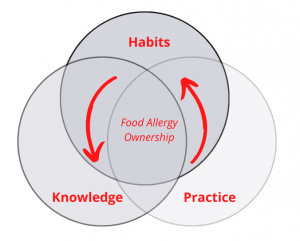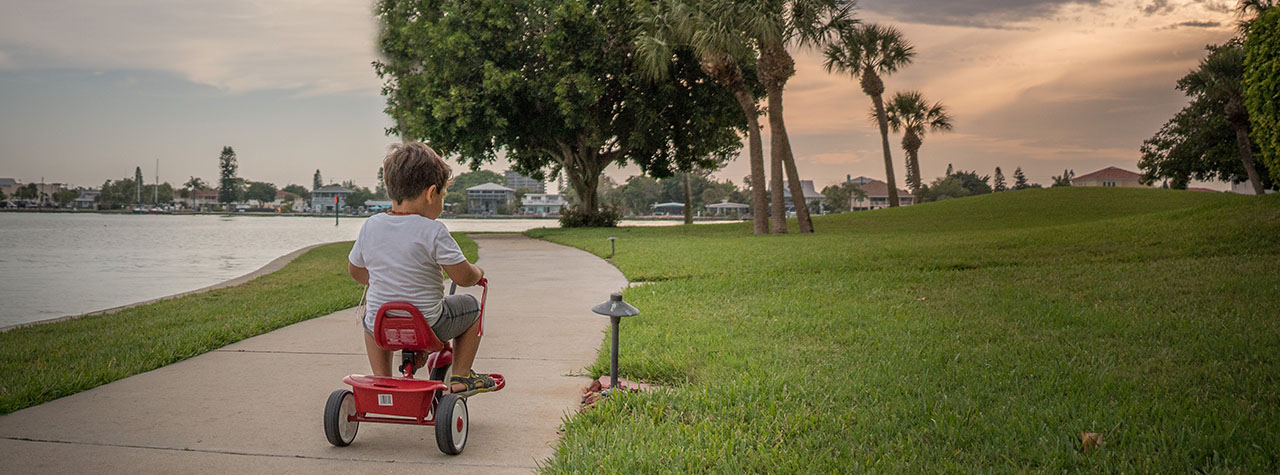This is a three part post series intended for families who have lived with a food allergy diagnosis for a while, have mastered basic food allergy management skills, and are wondering how to transition food allergy responsibilities to their child with food allergies. This is the first post in a series on empowering your kids with food allergies, in age appropriate ways, to self-manage them in the future — it’s all about loving by letting go as your kids with food allergies grow.
Have you ever taught a child to ride a bike? They don’t learn to ride by watching you ride one. They have to acquire the basic skill themselves and then practice, practice, practice to master it. They may start out on a tricycle. Then it’s the two wheeler with training wheels with you hanging on to steady them. Then the training wheels come off and you hold your breath through the wobbles.
Empowering your child with food allergies to eventually self manage their allergies is much the same. It’s a gradual process. It happens over time. There are wobbles along the way, skinned knees, and possibly even some trips to the ER.
“As a first-time parent, if you were handed a kindergartener at birth, would you know what to do? Absolutely not! You’re not there…YET. ”
—Allergy Force interview with Lindsay Schultz, Founder of Feed Your Can
I had an ‘uh oh’ moment when my son committed to his college, second semester of his senior year in high school. I thought he’d mastered navigating restaurants with food allergies, but saw the skill was ‘wobbly’ — he would still skip over important details in his conversation with servers in a rush to get through it.
We assumed he had fully absorbed this important skill set by observing us practice it over and over, over the years. Not so much. Fortunately, we had time to tighten up the skill set and build his confidence in it before he left for his freshman year.
Since it’s not a given that a child with food allergies will outgrow all their food allergies, it’s important to equip them with the skills they’ll need to self-manage them as adults. The process starts years before you find yourself saying goodbye on freshman move-in day.
Conceptually, it looks something like this:

A Biological Hurdle
Beyond the massive amount of food allergy information you need to transfer and your child needs to process, remember, practice, recall and apply in the right way at the right moment, there’s a biological hurdle that makes parenting {all} teens ‘interesting’ — the development of the adolescent brain.
How many times have you asked your teen with totally justified parental aggravation, “WHAT were you THINKING?”
The problem is, they weren’t — at least not with a fully developed brain.
“It is our choices, Harry, that show what we truly are, far more than our abilities.”
—Dumbledore in “Harry Potter and the Chamber of Secrets” by J.K. Rowling
The logical, decision-making part of the brain — the prefrontal cortex — matures into early adulthood, until about age 25 or so. This is the part of the brain that responds to situations with good judgment and awareness of consequences. It’s the seat of impulse control.
Teenage brains work differently than adult brains, particularly when they are making decisions or trying to problem solve. Teenagers’ decision-making and problem solving is seated in the amygdala, the part of the brain that controls emotions, impulses, aggression and instinctive behaviors like the fight or flight response to danger.
With the amygdala driving decision-making during the teen years, teenagers are more likely to act before they think, give little thought to the risks and consequences of their actions. Research suggests that teens weigh potential rewards, like social acceptance and belonging, more heavily than possible dangers — concerning enough when your teen doesn’t have food allergies, even more concerning when they do.
This doesn’t mean that your teen with food allergies is destined to make poor, impulsive decisions and put themselves in life threatening situations.
According to an Allergic Living article, Food Allergy Meets the Teenage Brain, “Impulse control improves with age, and external factors (such as stress, exhaustion or hunger) can cause it to unravel. For parents, the trick is to figure out how to harness the impulse control that adolescents do have…”
There are ways you can help them, in the moment, to safely navigate this intense period of uncertainty, exploration and growing independence — from communicating openly with respect, without judgement, without prying, to involving them in boundary setting, to discussing risks and choices, to helping them anticipate awkward social scenarios and practice how to handle situations before they happen.
However, preparing your teen to navigate adolescence safely with food allergies is a process that can start well before you’re in the thick of it, almost as soon as you have their food allergy diagnosis in hand, when you still may be climbing the food allergy learning curve yourself.
Empowering your child with food allergies over time to fully self manage them when they are adults is an integral part of the food allergy parenting journey.
Transitioning Food Allergy ‘Ownership’ To Your Child
Helping your children learn to take responsibility for their food allergies requires (1) forming good habits, (2) transferring {lots} of knowledge, and (3) practice-practice-practice. Over time.

In some cases you drive the process, like helping them form and practice good habits.
In some cases you transfer your knowledge to them in age appropriate ways {think bite-sized chunks} when they are developmentally ready to process and absorb it.
In some cases you enable the skills acquisition process by providing resources and accessories that make allergic living easier, often with their input on final selections (like snack packs in their favorite color, or a wearable medication bag, or a comfortable & cool allergy ID bracelet.)
In some cases you encourage them to practice skills and give them the time and space to do so, and the grace to mess up and learn {rebound} from their mistakes.
Forming Good Habits, Generally
An important part of empowering your child is forming good food allergy management habits, starting early in life.
“Habit is the intersection of knowledge (what to do), skill (how to do), and desire (want to do).”
—Stephen R. Covey, Author of “The 7 Habits of Highly Effective People”
Habits are the brain’s way of optimizing for efficiency and occur with little to no thought once they are formed (like brushing teeth, or tying shoelaces, or looking both ways to cross a street.) In contrast, routines are deliberately practiced (like doing homework right after school, or reading a story before bedtime). While both are regular, repeated actions, habits tend to run on autopilot while routines require intention and effort.
Habits can be systematically formed. They can be good or bad. They can be broken and discarded. Routines can become habits over time.
For good habits to stick it’s helpful to stack or add them onto something you do already — you start small, you do them everyday, you make them easy to do, and you celebrate successes. Behavioral scientist BJ Fogg, PhD, who founded the Behavior Design Lab at Stanford University and wrote “Tiny Habits: The Small Changes That Change Everything,” innovated the ideas that underlie the concept of habit stacking. To dive deeper and learn more about the power of stacking habits, check-out the resources shared below under ‘Learn More.’
Forming Good Food Allergy Habits, Specifically
Aspects of allergic living readily lend themselves to routines, with potential to become habits.
For example, it can begin as a routine, slipping on your child’s allergy ID bracelet or necklace when getting them dressed for school. The allergy ID jewelry becomes just another part of their daily outfit. In time, wearing it becomes a habit and it will feel weird to leave the house without it. It’s far easier to start forming the habit of wearing allergy ID jewelry when your child is starting preschool, than introducing it when they start middle school or high school. It’s part of their ‘normal’ getting dressed routine — shirt, pants, socks, shoes…allergy ID bracelet or necklace.
The timing for forming different allergy management habits will vary, but it all begins by enabling and modeling the skills you want your child to learn — the habits you want your child to form — as they mature. Enabling means you have the right resources and accessories available to support the habit you’re encouraging. Enabling also means you’re committed to investing the time & effort required to support a habit’s development.
Think about the need to keep epinephrine within reach at all times in case an allergic reaction strikes. What habits can you create to keep epinephrine within reach at all times?
Enabling
- Letting your child choose a medication or ‘epi bag’ in a style and fun color they like.
- Having your child help you pack the epi bag when you ready it for use the first time, and talking through each and every thing you put in the bag, from the antihistamine, to the autoinjectors x 2, to their Emergency Action Plan, to an inhaler and possibly a spacer.
- Creating a secure at home place for the epi bag — where it always lives when you’re home.
- Designating an on-the-go home for the epi bag — where it always lives when you’re out and about, e.g., your purse, the snack bag, their backpack (depending on their age), the family backpack.
Modelling
- Keeping the epi-bag on a hook by the door you use to leave home so you and your child are physically reminded to take it each time you go out.
- Replacing the epi-bag on it’s special hook by the door each time you return home.
- Doing an epi bag check-in each and every time you’re about to leave home, starting by asking your child, “Do we have our epi-bag?”
- If you ever leave home without the epi-bag, making it a BIG DEAL to turn around and retrieve it when it’s MIA, even if you’re running late.
Examples of some other allergy ‘survival’ skills with potential to become good {allergic living} habits are:
- Reading food labels before buying any packaged food, even foods you’ve purchased before.
- Explaining food allergies to wait staff at restaurants each and every time you dine out.
- Always carrying an extra safe snack (or two).
- Bringing safe food to every playdate, every party, every gathering.
As a food allergy parent you always want to be in food allergy hand-off mode with your child, with one eye on the here and now, and one eye on the future.
The formation of good allergic living habits is an important tool in your toolkit for supporting the gradual hand-off of food allergy responsibility to your child.
“The challenge is to set up systems that are likely to create habits, not sprints that lead to failure.”
—Seth Godin, Bestselling Author || Entrepreneur || Speaker
Learn More
Adolescent Brain Development
General
- Article from the American Academy of Child & Adolescent Psychiatry: Teen Brain: Behavior, Problem Solving, and Decision Making
- Article from University of Rochester Medical Center: Understanding the Teen Brain
- Article from www.raisingchildren.net.au, the Australian parenting website: Brain Development in Pre-teens and Teens
Food Allergy Specific
- Article by Heather Hewett for Allergic Living: Food Allergy Meets the Teenage Brain
- Article by Laura Bantock for Allergic Living: Beyond the Eye Roll and Tune Out: How to Talk to Teens About Food Allergies
Forming Good Habits
- TedxFremont talk by BJ Fogg: “Forget big change, start with a tiny habit”
- Article by Elizabeth Dougherty ( McGovern Institute for Brain Research) for MIT News: Wired for habit
- Article by Erin Eatough, PhD for www.betterup.com: Building good habits in your life (and ditching bad ones)
- Article by James Clear—Bestselling Author, Speaker: How To Start New Habits That Actually Stick
- Article by James Clear: How to Build a New Habit: This is Your Strategy Guide
- Post by Seth Godin—Bestselling Author, Entrepreneur, Speaker: Make a habit/break a habit
Part 2 of this empowerment series explores the types of food allergy knowledge & know how you will want your child to ‘own’ when they leave home. Part 3 of the series dives deeper into practical approaches for handing off food allergy responsibilities to your child over time. And, don’t miss Allergy Force’s downloadable resources with specific tactics for empowering your child with food allergies in age appropriate ways.
 |
Empowering people to live more easily & safely with food allergies through technology and education. |
| About the Author: Gayle Rigione is CEO of Allergy Force, the food allergy management app. She’s also an allergy mom. She’s lived the heart stopping moments when her son ate the wrong thing, second guessed reactions and spent the night in the ER. Her professional and personal experiences fuel her passion for creating tools for people with food allergies. Whatever you do, do it with a full heart. Audentes Fortuna Iuvat | |
Credits: Images courtesy of Allergy Force and Karo Kujanpaa on Unsplash


